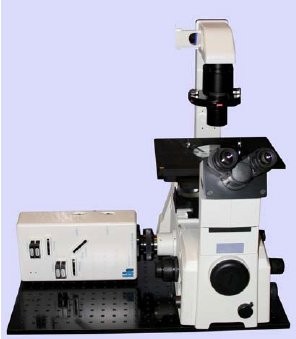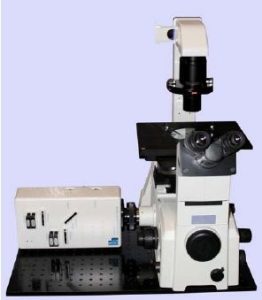The DCS-120 can convert an existing conventional microscope into a fully functional confocal or multiphoton laser scanning microscope with TCSPC detection. Due to its fast beam scanning and its high sensitivity the DCS-120 system is compatible with live-cell imaging. Unlike conventional confocal systems, the DCS-120 system does not require an expensive laser scanning microscope. Instead, the scan head is attached to the side or backport of a conventional inverted microscope. Making this confocal laser scanning lifetime imaging system cost a fraction of the price of the big confocal systems.
DCS-120 functions include recording of FLIM or steady-state fluorescence images simultaneously in two fully parallel wavelength channels, laser wavelength multiplexing, multi-wavelength FLIM, time-series FLIM, ultra-fast time-series recording by temporal-mosaic FLIM, spatial mosaic FLIM, Z stack FLIM, phosphorescence lifetime imaging (PLIM), fluorescence lifetime-transient scanning (FLITS) and FCS recording.
Applications focus on metabolic imaging, i.e. the use of lifetime changes by interactions of fluorophores with their molecular environment. Typical applications are ion concentration measurement, FRET experiments, metabolic imaging, imaging of fast physiological effects, and plant physiology.
Data analysis is performed by BH’s new SPCImage NG FLIM analysis software. SPCImage NG is a combination of time-domain and phasor analysis. By running the calculations on a GPU (Graphics Processor Unit) the results are available within seconds. Other features are the availability of image segmentation via the phasor plot or via 2D time-domain histograms, and automatic modelling of the system IRF. Repeated recalibration by recording the actual IRF is thus unnecessary.
Key Spec
- Complete confocal laser scanning FLIM Systems, including microscope and lasers
- Confocal FLIM upgrades for existing conventional microscopes
- Excitation by two BDS-SM ps diode lasers
- Excitation wavelengths from 375 nm to 640 nm
- Scanning by fast galvanometer mirrors
- Two confocal detection channels
- Suppression of scattering and straylight
- Channel separation by dichroic or polarising beamsplitters
- Individually selectable pinholes and filters
- Recording by bh’s multidimensional TCSPC process
- Two fully parallel TCSPC FLIM channels
- Time channel width down to 405 fs
- Ultra-fast and ultra-sensitive detectors
- Unprecedented time resolution
- Detection of lifetimes <25 ps
- Near-ideal photon efficiency
- Excellent lifetime reprodicibility
- Fast online-FLIM
- Megapixel FLIM, 2048 x 2048 pixels
- Precision FLIM, 4096 time channels
- Mosaic FLIM
- Z Stack FLIM
- Accumulation of fast time series
- Excitation wavelength multiplexing
- Multi-wavelength FLIM
- Simultaneous FLIM/PLIM
- Integrated motorized sample stage
- Data analysis by bh SPCImage NG
- Ultra-fast processing by GPU
- A combination of time-domain analysis and Phasor plot
- Image segmentation by Phasor plot or 2D histograms
- MLE Fit of decay curves
- Automatic IRF modelling
- No need to record IRF








